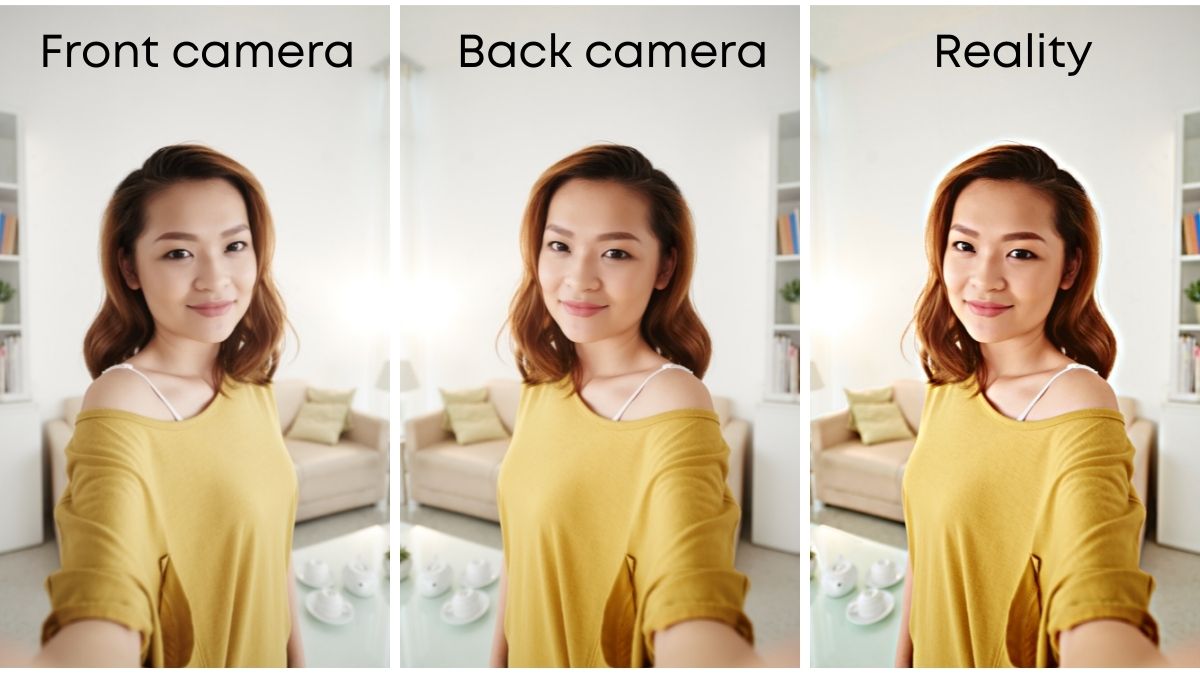The addition of quality cameras to smartphones led quickly onto both back and front facing cameras. However, if you look closely at the photos taken with both cameras or even the specifications, you may wonder whether the back camera is how others see you.
The back camera is the most accurate reflection of you as seen by others as the front camera generally has a wider lens, making the photo look like it has a fishbowl effect, and will take inverted pictures by default. Inverted pictures mean the image is flipped.
Let’s look into the differences between back and front cameras, how they work, why images flip and why you look different between a photo taken by the front camera and the rear camera.
What’s More Accurate: Front or Back Camera?
Most phones that have a front and back camera will put a much better quality camera on the back than on the front.
Another issue is that cell phone manufacturers use different types of lenses for the front and back camera. This means a back or rear-facing camera will be wide-angle meant for taking larger backgrounds.
Front-facing lenses will be an even wider lens than the rear-facing, otherwise, it would be really hard to fit a lot of the subject on there when using it, such as for selfies that will often be at most arms-length.
Thus this angle is to get the most out of the common use cases of front-facing cameras. If you compare two photos taken with the front- and rear-facing camera, you will notice that the image seems a bit stretched or has more of a fishbowl look for the front-facing camera.
Some camera sensors and lenses will be very different, with back cameras being up to five or higher factors higher than the front-facing camera. For example, you can get a 10MP camera on the back, and a 2MP camera on the front.

Is the Back Camera Inverted?
The back or rear camera is not taking an inverted image. You can test this for yourself, and you will notice that whatever is on the left of the photo, will be on the left of the real object.
So the back camera is taking a ‘true’ picture, an accurate representation of what the object looks like, which makes sense as you will be looking at the screen of the device while taking the photo, meaning it is important that the screen matches the ‘true’ picture.
However, the front-facing camera will always take an inverted picture. You can get some apps, such as Truth Mirror, that will take ‘true images’ without inverting it.
The reason why the front camera is inverted, is that it means that the image will be mirroring your face when using the camera for live things, such as taking a selfie, using Facetime for a video call or doing a video conference such as over Zoom or Microsoft Teams.
If it didn’t do this, when you were looking at your own face, it would be flipped from how your face is when facing the camera, throwing you off. Thus it is a pragmatic decision to do this only for the front-facing camera.
Why Do You Look Different in Front Camera and Back Camera?
There are several factors making you look different between the front and back camera on a device.
The main reason is that the cameras are unlikely to be the same. The sensor, lens and other components are going to be different for the rear camera as, generally, this is the better camera.
Most people are taking photos with the rear camera, especially landscape or background photos that they want to look good. So the megapixels, quality and type of lens is optimized for these bigger photos.
The front-facing camera is going to be lesser quality and is also a much wider lens, making more a type of fisheye lens look or making things appear narrower, which is just an optical illusion to fit more into the frame.
The image will also be inverted or flipped.
Another part is that the angle that the photo is taken from will be quite different depending on the front or back camera. If you can see your screen, such as when using the front camera, you can make micro adjustments to take a better photo.
You can’t generally do this with the rear camera, and so the angle will make a big difference as to how you look.
The distance of the camera from the object will also be quite different on average when considering it compared to one taken with a rear camera to the front-facing camera. This is more often than not limited by your own arms, as this is how far you can take a photo.
If you’re using a rear-facing camera, the device will have the option of being a lot further back because they’re not taking a selfie, which by definition is always going to be limited by your arm, or perhaps a little bit longer with a selfie stick.
Can the Front Camera Flip Photos?
By default, the front camera will take a flipped or inverted photo.
You can turn this off with some phones, such as with the iPhone by going into Settings, then tap on Camera.
Here, you will see a setting you can tap called Mirror Front Camera. Toggle this on to take ‘normal’ pictures that aren’t flipped as this will stop the front-facing camera from flipping or mirroring your selfies.
Keep in mind that this will make selfies or other uses such as video conferencing a bit discombobulating as your image will be not one to one with your actual face (or whatever it is that you’re filming with the front-facing camera).
There doesn’t seem to be an easy way to do this via settings for Android phones, but many apps like Instagram, Messenger, Snapchat and others support this for taking photos and recording film. So just open these up before doing your art.
What’s More Accurate: A Mirror or Back Camera?
It’s firstly important to realize that both mirrors and cameras can be inaccurate, but a mirror is likely to be the more accurate representation.
While mirrors can distort shapes and sizes, especially if not a ‘standard’ mirror like a mirror with a lot of magnification, a normal mirror with no magnification or being overly convex or concave will be a fairly accurate representation of reality.
However, mirrors tend to be more accurate than cameras, despite suffering from the major difference which is the image being flipped from front to back.
A back camera will come in many different types, depending on phone model, brand, price and year. However, a quality camera with a lens that is not too wide angle and has a quality sensor, will take a very good photo.
Lighting, lens cleanliness and so many other factors will go into a photo’s quality, so if you’re not keeping track of all these things it can be very easy even with a quality back camera to take a bad photo, whereas a mirror will almost always give a good quality reflection.


